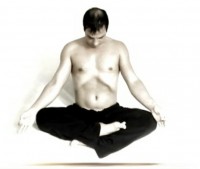First find a comfortable seated position
Finding a comfortable seated position is one of the first steps we make in our journey into meditation. If we cannot find comfort when we sit the mind will be continually distracted. If we find to much comfort the mind will drift away or fall into sleep.
Simple Candle meditation techniques
Light a candle in a wind free environment.
Gaze at the candle for as long as you can. When thoughts distract you visualize air passing through the mind and then return your gaze to the candle. Do this for at least 5 minutes.
Simple Mantra Meditation
Take a moment to clear your mind. Then begin to repeat a small peaceful sentence such as, "calmness in the mind", or something short and soothing but make sure you stick with one. It will gain momentum and power as time goes on.
Repeat this sentence verbally. If you get tired repeat internally.
After 3 - 5 minutes begin to repeat your short Mantra only when thoughts arise.
Simple Aum meditation
Begin a humming sound when you exhale. Make it deep so that its waveforms are longer. Try to sense a sound that is occurring in the universe when you do this. Make them both the same. You are now tuned in to a different vibration.
If you can do these techniques for more than 10 minutes a day consistently you are on your way to a good start when beginning meditation.
Beginner Meditation Tips
1. Proper seated posture is important in meditation, incorrect posture suppresses the lungs and blocks vital energy flow. Use a cushion or support when sitting.
2. Over time ,while sitting in meditation, posture often worsens due to the muscles fatiguing. If the muscles are inflexible the body will act against itself while sitting. In attempting to maintain a good seated posture muscles tire causing a curve in the shoulders and in the lower back. Therefore learn good posture and do stretches that help reduce the forces from muscles acting against the body in seated meditation.
3. The element of water can cease flowing in areas that are compressed. This will result in numbness and needle like pain. Manipulate the chosen seated posture so that the element of water flow freely.
4. When meditating allow air to flow in and out of the body with ease during meditation. The mind relaxes when the breath is very light and unobstructed. Any kind of conflict in the breathing will be reflected in the mind. Learn to breathe calmly and smoothly.
5. Irregular breathing causes the mind to wander and focus to be lost. Therefore practice breathing techniques that encourage rhythmic breath and have a calming effect on the nerves.
6. Try to open the nostrils and sinuses with the mind. Hidden conflict often occurs causing the valves to restrict incoming air. The mind has the ability to influence opening in the nasal passages, hidden mental disturbance may be causing them to tense and restrict. Bring attention to this periodically and remove the conflict.
7. Pass across from inhalation to exhalation without strain. Trying to inhale too deeply is a common mistake that strains the nerves and causes pressure and force in the mind.
9. Allowing a little air to remain in the lungs after exhalation requires less effort and as a result is calmer on the mind. The mind begins to panic if no oxygen is present. Relaxing after exhalation leads to a calm nervous system.
10. When the diaphragm changes direction after the exhalation there is a lot of change within. The order of flow is changing during this time. Make the transition smooth so that it does not disturb the mind.


